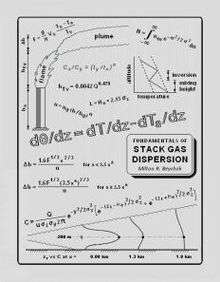Fundamentals of Stack Gas Dispersion
 The book's cover | |
| Author | Milton R. Beychok |
|---|---|
| Language | English |
| Subject | Air dispersion modeling |
| Publisher | Milton R. Beychok |
Publication date | 2005 (4th Edition) |
| Media type | Downloadable in PDF format |
| Pages | 201 (21.5 cm × 27.6 cm) |
| ISBN | 0-9644588-0-2 |
| OCLC | 33462889 |
| 628.5/32 | |
| LC Class | TD885 .B49 1994 |
Fundamentals of Stack Gas Dispersion is a book devoted to the fundamentals of air pollution dispersion modeling of continuous, buoyant pollution plumes from stationary point sources. The first edition was published in 1979. The current fourth edition was published in 2005.
The subjects covered in the book include atmospheric turbulence and stability classes, buoyant plume rise, Gaussian dispersion calculations and modeling, time-averaged concentrations, wind velocity profiles, fumigations, trapped plumes and gas flare stack plumes. The constraints and assumptions involved in the basic equations are fully explained.
The book has received favorable reviews, including a description of its "simple straightforward explanations" for a "full course in single-source dispersive modeling".[1][2][3]
The book has been purchased in 84 countries and as of 2015 is available in 233 libraries worldwide.[4] It has been referenced or cited as an educational resource more than 880 times in the technical literature and on the Internet, including 34 regulatory publications of state or national governmental agencies worldwide. It has also been used as recommended reading or a textbook in 61 university courses.[4]
The book is now available only as a downloadable version in PDF format.
Book contents
|
|
Book reviews
- James P. Lodge (November 1995), "Book review", Atmospheric Environment, Vol. 29, No. 22, p. 3397,ISSN 1352-2310:[5]
A good number of years ago, I reviewed an earlier edition of this work quite favorably. Having read through, with puzzlement, other explanations of stack gas dispersion, I was greatly taken with the simple, straightforward explanation of the steps to get from emission and meteorological data to the expected downwind concentrations. Now, the author has produced a much more comprehensive volume that takes you from raw data to final concentrations, using the same approach. In a word then, this is a rather full course in point-source dispersion modeling. The work is overall as unique as it claims to be, in presenting this subject in a straightforward, informal fashion. I plan to put my copy on the shelf next to my desk where I can reach it. I recommend it.
- Karen Kowalewsky (January 1997), "Book reviews", Bulletin of the American Meteorological Society, Vol. 78, No. 1, pp. 90–94,ISSN 0003-0007:
The goal of this text is to provide the reader with the fundamentals of dispersion models, deriving them stepwise with examples, while avoiding complex mathematics. Overall, the book meets the goal of explaining the basic theory. All of the material given was technically sound and complete. The table of contents, the lists of tables and figures, and the references were complete. The examples were quite detailed and assisted in explaining the main subjects. The historical and engineering aspects of this book will be useful to any meteorologists or engineers working in the field of air pollution meteorology. I believe this book is a useful reference and plan to have it at work in the frequently consulted dispersion modeling section of my bookshelf.
- Stanley S. Grossel (August 1995), "Book review", Chemical Engineering Progress, Vol. 91, No. 8, p. 88,ISSN 1352-2310:
The author wrote this book because he felt there was no single reference source that clearly explained the fundamental theory and discussed the many assumptions and constraints involved in its derivation. The book starts "from scratch" in deriving the fundamental theory step-by-step, and it also provides many sample calculations serving to elucidate the theory and procedures. All major aspects of (buoyant) gas dispersion are covered here in a manner easily followed by the non-specialist engineer. The calculation samples appreciably help in illustrating the theory and design procedures. This book will be a useful addition to the bookshelf of all engineers faced with estimating the effects of stack gas dispersion.
See also
- Accidental release source terms
- ADMS 3
- AERMOD
- Air pollution dispersion terminology
- Air Quality Modeling Group
- Atmospheric dispersion modeling
- Bibliography of atmospheric dispersion modeling
- List of atmospheric dispersion models
- UK Atmospheric Dispersion Modelling Liaison Committee
- Useful conversions and formulas for air dispersion modeling
References
- ↑ Atmospheric Environment, Volume 29, Issue 22, November 1995, page 3397, Elsevier B.V., reviewed by James P. Lodge. doi:10.1016/1352-2310(95)90214-7
- ↑ Bulletin of the American Meteorological Society, January 1997, pages 90-94, American Meteorological Society, reviewed by Karen Kowalewsky
- ↑ Chemical Engineering Progress, August 1995, page 88, American Institute of Chemical Engineers, reviewed by Stanley S. Grossel
- 1 2 Complete lists of countries, libraries and references/citations Archived October 5, 2006, at the Wayback Machine.
- ↑ Lodge Jr., James P. (1980). "Fundamentala of Stack Gas Dispersion (review)". Atmospheric Environment. 14 (7): 865–866. doi:10.1016/0004-6981(80)90151-1. Retrieved 20 June 2014.
External links
- "Fundamentals of Stack Gas Dispersion". Archived from the original on 2014-12-16.
- "Book Reviews". Archived from the original on 2015-02-02.